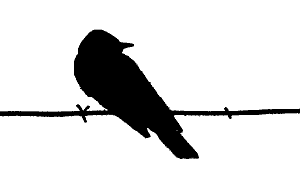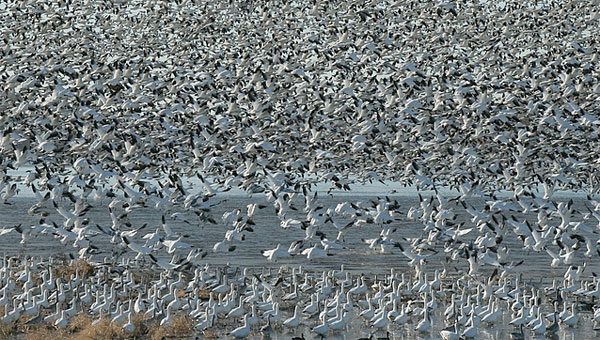Bird ID Skills: Behavior
There’s what birds wear, and there’s how they wear it.
A bird’s attitude goes a long way in identification.
Barn Swallows by Matt MacGillivray April 20, 2009Bird species don’t just look unique, they have unique ways of acting, moving, sitting, and flying. When you learn these habits, you can recognize many birds the same way you notice a friend walking through a crowd of strangers.
Chances are, you’ll never see a Cedar Waxwing poking through the underbrush for seeds – or a Wood Thrush zigzagging over a summer pond catching insects. But similar-sized birds such as towhees and swallows do this all the time. Behavior is one key way these birds differ.
Because so much of a bird’s identity is evident in how it acts, behavior can lead you to an ID in the blink of an eye, in bad light, or from a quarter-mile away. Before you even pick up your binoculars, notice how your bird is sitting, how it’s feeding or moving, whether it’s in a flock, and if it has any nervous habits like flicking its wings or bobbing its tail.
And remember that to get good at recognizing birds by their behavior, you must spend time watching them. It’s tempting to put down your binoculars and grab your field guide as soon as you see a field mark. Or, after identifying a common bird, you might feel rushed to move on and find something more unusual. Resist these urges. Relax, and watch the bird for as long as it will let you. This is how you become used to the way a bird acts, how you discover it doing something new – and let’s face it, it’s probably why you went out bird watching in the first place.
Posture
The most basic aspect of behavior is posture, or how a bird presents itself. You can learn to distinguish many similarly proportioned birds just from the poses they assume. It’s a skill that includes recognizing a bird’s size and shape, and adds in the impression of the bird’s habits and attitude.










For example, in fall the small, drab green Pine Warbler looks similar to the Acadian Flycatcher, right down to the two wingbars and the straight bill. But you’re unlikely to confuse the two because their postures are so different. Pine Warblers hold their bodies horizontally and often seem to crouch. Flycatchers sit straight up and down, staying on alert for passing insects.
Horizontal versus vertical posture is the first step. Next, get an impression of the bird: Does it seem inquisitive like a chickadee or placid, like a thrush? Does it lean forward, ready for mischief, like a crow? Or is it assertive and stiff, like a robin? Do the bird’s eyes dart around after targets, like a flycatcher – or methodically scan the foliage like a vireo? Is the bird constantly on alert, like a finch in the open? Nervous and skittish like a kinglet?
Movement
As soon as a sitting bird starts to move, it gives you a new set of clues about what it is. You’ll see not only different parts of the bird and new postures, but you’ll also sense more of the bird’s attitude through the rhythm of its movements. There’s a huge difference between the bold way a robin bounces up to a perch, a mockingbird’s showy, fluttering arrival, and the meekness of a towhee skulking around.
You can also tell a lot from the way the bird moves: notice whether it hops, like many sparrows, or walks like a pipit; whether it always hitches upward like a woodpecker or scurries around like a nuthatch seemingly unaware of gravity.
On the water, some ducks, such as Mallard and Northern Pintail, tip up (or “dabble”) to reach submerged vegetation. Others, including scaup and Redhead, disappear from view as they dive for shellfish and other prey. Among the divers, you’ll notice that some species, such as eiders, open their wings just before they dive. These ducks flap their wings for propulsion underwater, and they almost always begin a dive this way.
Flight Pattern
Certain birds have flight patterns that give them away. Almost nothing flaps as slowly as a Great Blue Heron – you can see this from miles away. Learn the long swooping flight of most woodpeckers and you’ll be able to pick them out before they’ve even landed.




Many small birds, particularly finches, have bouncy, roller-coaster trajectories caused by fluttering their wings and then actually folding them shut for a split second. Other little birds, including wrens, warblers, and many sparrows, fly in a straight path with a blur of little wings.
Birds of prey have their own distinct styles. Red-tailed Hawks and other buteos fly with deep, regular wingbeats or soar in circles on broad wings. Accipiters like the Sharp-shinned Hawk give just a few stiff flaps and then glide. Falcons fly with powerful beats of their sharply pointed wings. The White-tailed Kite often hovers, wings beating, pointed into the wind.
Feeding Style
Much of the time that you watch birds on the move, you’ll be watching them feed, so it pays to become familiar with foraging styles. Some are obvious: the patient stalking of a heron; the continual up-and-back sprints of Sanderlings; the plunge of a kingfisher. But you can develop a surprisingly specific impression of almost any bird just from a few seconds of watching it forage.
For example, swallows, flycatchers, vireos, finches, and thrushes are all roughly the same size, but they feed in totally different manners. Swallows eat on the wing; flycatchers dart out from perches at flying bugs; vireos creep through leaves; finches sit still and crush seeds; and thrushes hop low to the ground eating insects and fruit.
Experts take this skill to incredible lengths – identifying distant seabirds on a choppy ocean just from the way they hold their wings, for example. But just as there are dozens of different ways for a person to eat an ear of corn, even closely related birds have developed their own telltale foraging habits. All it takes to discover them is time, practice, and your own powers of observation.
Flocking
A flock of kingfishers? A single starling all on its own? Some species seem to be born loners, and others are never found solo. Even among flocking birds, there are those content to travel in threes and fours, and others that gather by the dozens and hundreds.










A noisy group of yellow birds in a treetop is much more likely to be a flock of American Goldfinches than a group of Yellow Warblers. A visit to northern coasts in winter might net you several thousand Brant, but you’ll probably only see Harlequin Ducks by the handful. Learning the tendencies of birds to flock – and their tolerance for crowding – is one more aspect of behavior you can use.
Just remember that many species get more sociable as summer draws to a close. After nesting is over and young are feeding themselves, adults can relax and stop defending their territories. Still, some birds stay in large groups even in summer, sometimes even nesting cooperatively. Scientists have learned this often happens when a species’ food source is scattered and unpredictable, as with gulls and other seabirds, or when suitable nesting sites are hard to come by, as with many swallows.

All About Birds
is a free resource
Available for everyone,
funded by donors like you
American Kestrel by Blair Dudeck / Macaulay Library